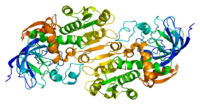
Photo from wikipedia
ABSTRACT Insertion of a single-chain variable-fragment antibody (scFv) to HER2 (human epidermal growth factor receptor 2) in gD, gH, or gB gives rise to herpes simplex viruses (HSVs) specifically retargeted… Click to show full abstract
ABSTRACT Insertion of a single-chain variable-fragment antibody (scFv) to HER2 (human epidermal growth factor receptor 2) in gD, gH, or gB gives rise to herpes simplex viruses (HSVs) specifically retargeted to HER2-positive cancer cells, hence to highly specific nonattenuated oncolytic agents. Clinical-grade virus production cannot rely on cancer cells. Recently, we developed a double-retargeting strategy whereby gH carries the GCN4 peptide for retargeting to the noncancer producer Vero-GCN4R cell line and gD carries the scFv to HER2 for cancer retargeting. Here, we engineered double-retargeted recombinants, which carry both the GCN4 peptide and the scFv to HER2 in gD. Novel, more-advantageous detargeting strategies were devised so as to optimize the cultivation of the double-retargeted recombinants. Nectin1 detargeting was achieved by deletion of amino acids (aa) 35 to 39, 214 to 223, or 219 to 223 and replacement of the deleted sequences with one of the two ligands. The last two deletions were not attempted before. All recombinants exhibited the double retargeting to HER2 and to the Vero-GCN4R cells, as well as detargeting from the natural receptors HVEM and nectin1. Of note, some recombinants grew to higher yields than others. The best-performing recombinants carried a gD deletion as small as 5 amino acids and grew to titers similar to those exhibited by the singly retargeted R-LM113 and by the nonretargeted R-LM5. This study shows that double retargeting through insertion of two ligands in gD is feasible and, when combined with appropriate detargeting modifications, can result in recombinants highly effective in vitro and in vivo. IMPORTANCE There is increasing interest in oncolytic viruses following the FDA and European Medicines Agency (EMA) approval of the oncolytic HSV OncovexGM-CSF and, mainly, because they greatly boost the immune response to the tumor and can be combined with immunotherapeutic agents, particularly immune checkpoint inhibitors. A strategy to gain high cancer specificity and avoid virus attenuation is to retarget the virus tropism to cancer-specific receptors of choice. However, cultivation of retargeted oncolytics in cells expressing the cancer receptor may not be approvable by regulatory agencies. We devised a strategy for their cultivation in noncancer cells. Here, we describe a double-retargeting strategy, based on the simultaneous insertion of two ligands in gD, one for retargeting to a producer, universal Vero cell derivative and one for retargeting to the HER2 cancer receptor. These insertions were combined with novel, minimally disadvantageous detargeting modifications. The current and accompanying studies indicate how to best achieve the clinical-grade cultivation of retargeted oncolytics.
Journal Title: Journal of Virology
Year Published: 2017
Link to full text (if available)
Share on Social Media: Sign Up to like & get
recommendations!